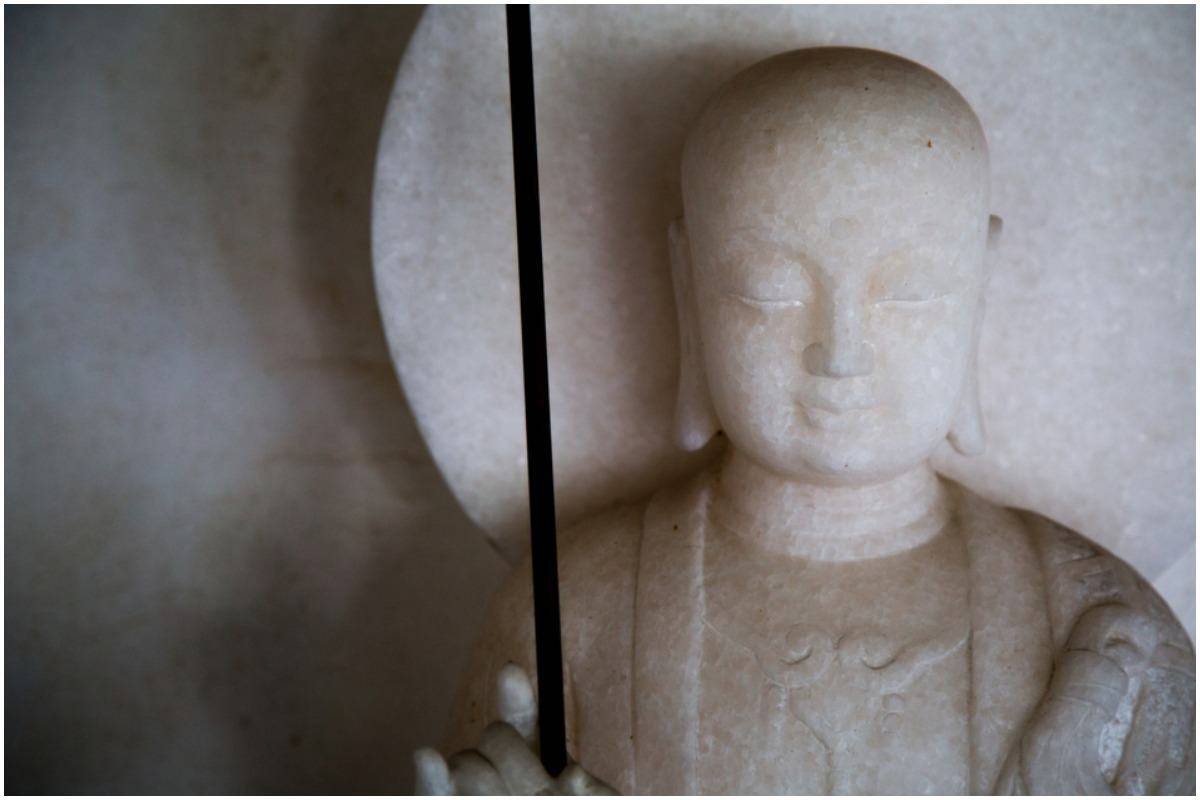What is the meaning of the Ksitigarbha (Jizo) Bodhisattva mantra?
Introduction
Bodhisattva Ksitigarbha is usually referred to as the Bodhisattva of the Hell beings due to His vow to not achieve Buddhahood until all hells are vacated.
He is one of the four main Bodhisattvas in East Asian Mahayana Buddhism. The other Bodhisattvas are Manjusri, Samantabhadra, and Avalokitesvara.
The name of this Bodhisattva translates as “the one who encompasses the earth.”
Earth signifies hardness, stillness, stability, versatility, and vastness.
Also, it represents our mind which creates all dharma and accommodates all matters.
Earth is the foundation on which everything grows. Store signifies profundity, subtleness, and deepness. In addition, store signifies the immeasurable treasures.
The Bodhisattva helps living beings in other realms, for instance – celestial beings, humans, hungry ghosts, asuras (demons), insects, and animals.
He is also regarded as the guardian of children and patron deity of deceased children and aborted fetuses in Japanese culture, where He is known as Ojizo-sama or Jizo.
The story of this Bodhisattva was first described in the Ksitigarbha Bodhisattva Purvapranidhana Sutra, one of the most popular and important Mahayana sutras.
This sutra is said to have been spoken by the Gautama Buddha towards the end of his life to the beings of the Trayastrimsa Heaven as a mark of remembrance and gratitude for his beloved mother, Maya.
Shakyamuni Buddha says that deities, devas, nagas, demons, or humans who hear Bodhisattva Jizo’s name and thereafter praise, worship, or show obeisance to images or sutras of Bodhisattva Jizo will gain the following 7 benefits:
- They shall be free of all bad (negative) karma.
- They shall quickly climb the divine stages of advancement.
- They shall eventually achieve Buddhahood.
- They shall experience greater willpower to do good.
- They shall be guarded by all the Buddhas.
- They shall remember their past experiences and lives.
- They shall never again suffer setbacks along the Bodhi path.
ALSO READ: Aham Brahmasmi – I am that Brahman Meaning
Iconography
The Bodhisattva is usually depicted in the standing posture (Samapada), with each foot on a multi-layered lotus pedestal.
The Bodhisattva appears in the form of a bhikshu (an ordained male monastic) carrying a mendicant’s staff in his right hand.
In his left hand, Jizo Bodhisattva cradles a cintamani of wish-fulfilling jewel.
The cintamani is occasionally named the Pearl Beyond Price in the East.
In addition, He is sometimes portrayed wearing a crown like the one worn by Buddha Vairocana.
His image is similar to that of the fictional aspect of Xuanzang from the classical novel Journey to the West, so observers occasionally mistake Bodhisattva Ksitigarbha for the latter.
In Japan, Ksitigarbha is respectfully known as one of the most loved of all Japanese divinities.
Bodhisattva Ksitigarbh statues are a common sight, particularly in graveyards and by roadsides.
Traditionally, the Bodhisattva has been worshiped as the guardian of the souls of Mizuko, the souls of stillborn, miscarried, or aborted fetuses. Firefighters are also believed to be under His protection.
Jizo (Ksitigarbha) Bodhisattva mantra lyrics in Sanskrit:
”Om ha ha ha vismaye svaha.”
Chanting Earth Store Bodhisattva mantra benefits:
This powerful mantra is to be used for any problems or difficulties. Reciting this Buddhist mantra 108 times daily is the best tool for any problems in any situation.
”The Bodhisattva Ksitigarbha practice is particularly beneficial for those individuals who have serious health problems, heavy problems, financial difficulties, big projects, or are in danger of experiencing natural disasters such as earthquakes.” – Lama Zopa Rinpoche
Image credit – Chen Yen Ling/Shutterstock
READ MORE: 10 Powerful Ancient Tibetan and Sanskrit Mantras
- About the Author
- Latest Posts
Irina is a co-founder and author at AwakeningState.com, an online magazine launched in 2016 that aims to expand consciousness every day. Offering eye-opening articles on a range of topics, Irina strives to provide unique insights into personal growth, covering areas such as spiritual awakening, health, lifestyle, nature, and science.
